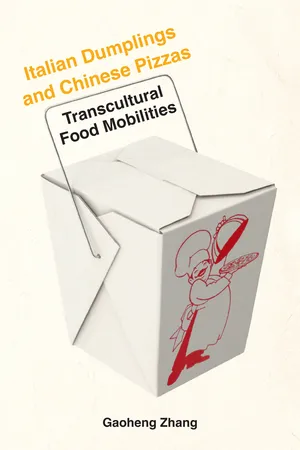
- English
- ePUB (mobile friendly)
- Available on iOS & Android
About this book
Designs a novel analytical framework to approach transcultural food mobilities, a culinary phenomenon that has been with us for decades as a result of colonialism and globalization
Why is it surprising for some of us to read the pairing of "Chinese" with "pizzas" and "Italian" with "dumplings," such as proposed in the book's title? After all, in some regions of the two countries, Italians eat frequently dumplings, and Chinese frequently make baked, steamed, or fried flatbread with toppings or fillings. Furthermore, when dumplings are made in Italy by Chinese migrants or Chinese Italians, or when pizzas are made in China by Italian migrants, Chinese Italians, or Chinese without apparent ties with Italy, are these culinary products Chinese, Italian, Chinese-Italian, or something else? Why do we need to care for such labeling dilemmas?
This book shows how China-Italy food mobilities relayed in popular culture helped forge Chinese and Italians' socioeconomic identities in recent decades by fundamentally shaping contemporary Chinese and Italian consumer cultures. This book addresses China-Italy food cultures against the backdrops of two epoch-making socioeconomic processes. During the 1980s, Chinese cuisine became the first non-European food widely available in Italy, thanks to the widespread presence of Chinese eateries. Only American fast food, which established itself in Italy around the same time, enjoyed comparable popularity as a destination for Italian culinary tourism. Meanwhile, in the early 1990s, together with American hamburgers and fried chicken, the American food chain Pizza Hut's pizzas and spaghetti were the first non-Asian foods that post-Mao Chinese customers recognized as "Western." The book proposes a critical framework that analyzes transcultural food mobilities by seriously assessing the confluence of diverse mobilities and their impact on food cultures. Ultimately, the study shows that a sophisticated interpretation of transcultural food mobilities can help address alterity and build understanding in a world of increasing political and cultural polarization.
Frequently asked questions
- Essential is ideal for learners and professionals who enjoy exploring a wide range of subjects. Access the Essential Library with 800,000+ trusted titles and best-sellers across business, personal growth, and the humanities. Includes unlimited reading time and Standard Read Aloud voice.
- Complete: Perfect for advanced learners and researchers needing full, unrestricted access. Unlock 1.4M+ books across hundreds of subjects, including academic and specialized titles. The Complete Plan also includes advanced features like Premium Read Aloud and Research Assistant.
Please note we cannot support devices running on iOS 13 and Android 7 or earlier. Learn more about using the app.
Information
Table of contents
- Cover
- Title Page
- Copyright
- CONTENTS
- Introduction: Transcultural China-Italy Food Mobilities
- 1. Chinese Migrants’ Food Entrepreneurship and Italians’ Culinary Tourism, 1962-2020
- 2. Romantic Waitresses vs. “Kung Food” Workers: Gendering the Chinese Restaurant
- 3. The Chinese Who Eat Dogmeat: Racialization of Chinese Food Consumption
- 4. Fighting “Yellow Mozzarella”: Italians Safeguard Food’s Authenticity
- 5. Pizza Hut, Fine Dining, and Trattorie: Italian Gastronomy Tourism in China
- 6. Slow and Fast, Sweet and Sour: Chinese Foodie Travelers in Italy
- Conclusion
- Acknowledgments
- Notes
- Bibliography
- Index
- About the Author